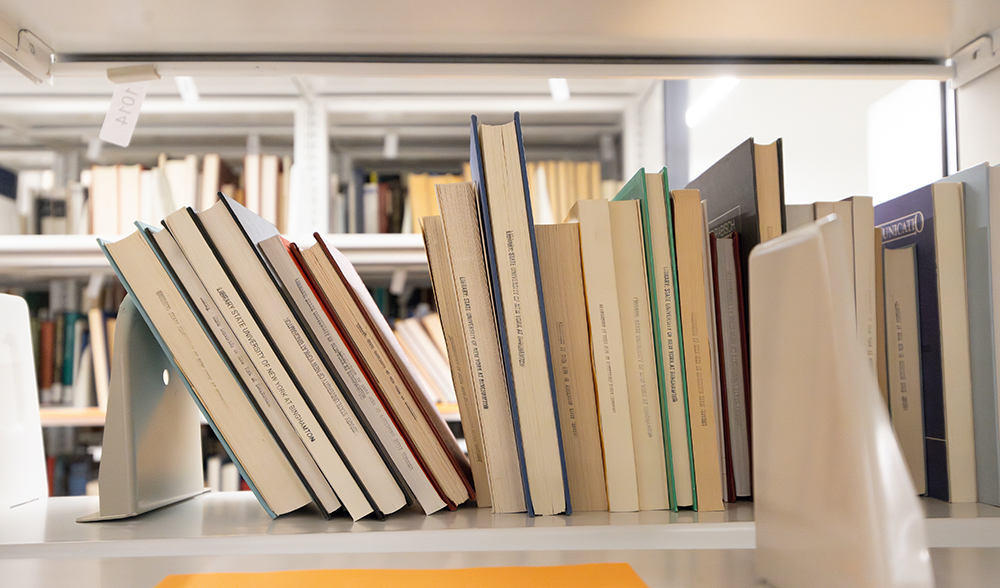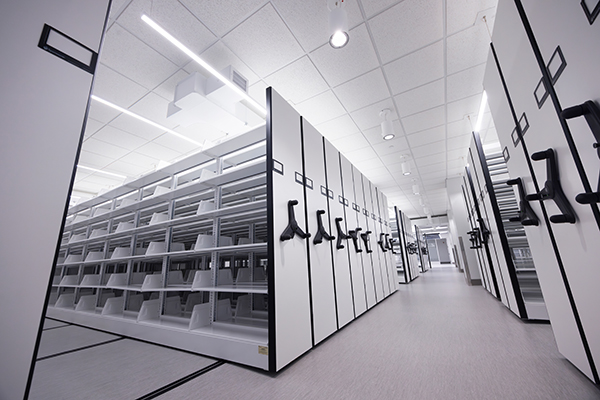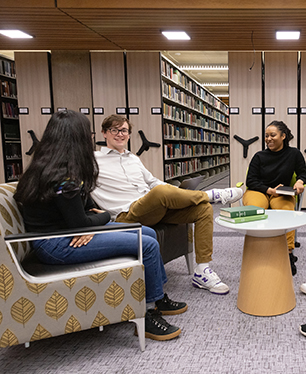New and long-term projects help University Libraries grow
Third-floor renovation to open; Collection Management Facility comes to Johnson City

While the movies might make libraries seem like dusty rooms full of old books or detention sites as in The Breakfast Club, few places on college campuses can serve as a greater hub for cultural and informational exchange. Libraries, like Binghamton University’s, make way for innovation while managing enormous quantities of knowledge, old and new.
“Libraries are constantly grappling with this stereotype of what a library is,” Dean of Libraries Andrea Falcone says. “It’s critical to have a diversified library — services, spaces, collections — that as a single person, I might not understand or even think of. There is something for everyone, at every stage of your academic or research career. We are here to support — but we’re probably even more than you think we are.”
Besides streaming services, e-resources and physical media, the Libraries offer collaboration spaces, technology platforms, research assistance and much more, all managed by a staff of 90 or so full-time employees and 130 students.
One way the Libraries make this all possible is by constantly growing. The progress is reflected in recent projects: a third-floor renovation in the Glenn G. Bartle Library and a move to the Collection Management Facility (CMF), where ever-expanding resources are finding a perfect niche in the academic landscape.
These developments will provide opportunities for the collection to best suit community need — and for existing assets, like Special Collections, to flourish.
“Libraries have greatly changed. We used to be gatekeepers of information — collections sat behind a locked room, and you had to talk to a librarian,” says Falcone, who began as dean in July 2023. “Now, you can search and access almost all of it on your own. That transformation is huge.”
In 1960, when the original library on the Vestal campus was completed, the collection contained only 80,000 volumes. Today, patrons can enjoy more than 1.8 million volumes, housed across four sites and a digital, searchable database.
Binghamton University Libraries consist of several departments and buildings that all rely on each other. The first level of this structure focuses on the four main locations where collections are stored: Bartle Library, in the center of the main campus; Science Library, located in the Science 2 complex; the University Downtown Center (UDC) Library; and the newest addition, the Collection Management Facility, at 10 Gannett Drive in Johnson City.
While each location holds a variety of subjects, the Science Library plays host to the Sustainability Hub and UDC supports the College of Community and Public Affairs (CCPA). All Libraries locations have their own staff managing resources.
Meanwhile, Bartle Library serves as a main hub, holding administration, reader services, the Information Commons, book processing, preservation, the Digitization Lab, Special Collections and, of course, the well-loved “stacks.”
An ambitious redesign
Since 2021, Bartle has been the site of motivated growth, when construction on its third floor began. This redesign forms a location for the permanent Digital Scholarship Center and a MakerLab for prototyping and fabrication, including 3D printing.
“The goal is to transform the floor into an innovative and inviting space for study, teaching and research,” says Nicki Chanecka, director of library administration. “The space will include areas for quiet study, collaborative work, instruction, research and our unique collection. Our Digital Scholarship Center will create a community of practice for research and activities in the digital realm on campus.”
Using the spaces will allow the community to connect with experts and materials in new ways. Analyzing trends and meaning to create visualizations in immersive multimedia formats is one opportunity; Falcone also envisions students “dreaming up something digital” in their curricula and making it physical to manipulate and test, or vice versa. She hopes the third floor will inspire Binghamton to solve community issues.
“This ability and confidence to find, assess, evaluate and then create information is so important,” Falcone says. “Understanding data is a skill set that will always be needed. It is not only about making current knowledge available, but helping people understand how they can contribute to and consume it, while allowing them to make their own decisions.”
The floor’s sleek, open-floor look also will be a draw. Another plus in favor of the remodel is its newfound ability to grow with the times and better reflect constituents.
“The third floor will allow for a lot of flexibility,” Chanecka says. “In years to come, when its resources have perhaps evolved differently or aren’t relevant in the way they are now — that floor is very wide open, and those spaces can be changed to bring in whatever’s next.”
Although construction is nearly complete, the space will require one more push to the end, for collections moving in. The floor is slated to open in early spring 2025.
“We have important core services, and we have great collections. But we are always elevating,” Falcone says. “Our digital scholarship services and our Collection Management Facility are keeping materials in perpetuity for the future. We are trying to future-proof our library, while also continuing to evolve with technology.”
Maintain and elevate
The third floor is not the only place that requires an expert manager’s eye. Matt Gallagher, the director of collection development, and Nancy Abashian, senior director of public services, are using their skill sets to keep every part of the Binghamton University collections exactly where it needs to be.
“Over the last five years and within the next five years, Libraries will have handled almost every single physical item in the collection, for relocation or review,” Gallagher says. “That is a massive undertaking, considering it’s taken us 60 years to accumulate.”
Keeping track of and expanding the collection is no easy task. Gallagher is responsible for financially stewarding research and curricular needs. One example of this activity is called evidenced-based acquisition (EBA) programs. Instead of librarians purchasing ebooks based on intuition, titles that were most used or of interest to faculty within the past year are purchased.
Meanwhile, Libraries must also maintain their already-owned resources. Using circulation data, Gallagher ensures that the most frequently used books stay, while relocating or withdrawing items not checked out recently. He also may look at other SUNY schools, to see if the Binghamton copy is the last version in the system or decide if one copy might be better suited in a digital format.
“Certain disciplines still like and want print,” Gallagher says. “In my opinion, academic libraries need to have both — and you need to make sure both the physical and electronic collections are operating together in a healthy fashion so that everyone’s needs are met.”
While Gallagher works behind the scenes, Abashian’s division is front-facing, ensuring users get exactly what they need when they need it.
“Public services are what people see when they walk in the door. It is their first point of engagement,” Abashian says. “Wherever the people are, we bring the collection to them. We move materials around, so people get the resources they want where it’s convenient.”
Only one thing is needed to ensure knowledge is passed along: room to grow. With third-floor renovations underway in 2021, as well as a bulging storage Annex in Conklin, N.Y., space was getting increasingly hard to find.
To answer that need, the Collection Management Facility was acquired to replace the former Annex. Over months, the Annex’s compendiums were evaluated and moved into their new home, the former Gannett Central New York building off of Route 17 in Johnson City.
The building’s vertical space can accommodate high-density storage, which allows significantly greater capacity. The building contains about 650,000 books and has enough space for about 350,000 more, or a million volumes in total. Instead of using a standard alphabetic filing system, the facility stores books by size and weight. Like a shipping fulfillment warehouse, this allows for much greater accessibility and speedier deliveries.
“Having 35% additional capacity gives us the flexibility to think about spaces here differently,” Gallagher says. “Having that extra space allows us to think about collections more coherently, so that we can expand student spaces to be more cohesive and user-friendly.”
The building is also temperature, pest and humidity controlled. The move to this location allows a greater degree of care and access, as the project also served as an inventory; every book was cleaned, sized and sorted, perhaps for the first time since being acquired. Rare or damaged books were also repaired or transitioned to Special Collections. Every document is available in the Find It! database, to a more accurate degree than before.
“We’ve learned how to manage our collection in a way that maximizes the space and efficiency in retrieval and delivery of materials,” Abashian says. “That allows us to be good stewards of important work, whether they’re important to us at this moment, in the future, or another institutional partner.”
Keeping the past safe
The Libraries’ collections don’t always end at a simple checkout, either. Some materials are given unique care in Special Collections. Many come from irreplaceable sources and revolve around rare topics — often the basis of independent and publishable scholarly research.
“Special Collections could really represent past, present and future, because it’s not all old ‘stuff.’ We have contemporary books that were created by artists this past year and archival collections,” Director of Special Collections and Library Preservation Blythe Roveland-Brenton says. “We have a very diverse collection; it’s not just classic old books in a back corner somewhere.”
So how does Special Collections acquire its items? That’s a more complicated answer than it might appear. While some might already have been in the general collections and need additional security and care, others may be purchased — adding to an already strong collection, or a collection that contains gaps — or created by students, like the yearly Book Arts competition, which awards the winning entry a spot in the collection each year.
“The most important thing in selecting material for purchase is how it’s going to be used in the classroom and curriculum,” Roveland-Brenton says. “We try to imagine the different ways that audiences could use them. And we like things that are not so pristine! We like the grubby books, where you can tell that there were multiple hands and pass through the generations with other people’s bookplates, little handwritten annotations. That is the fuel for student research projects.”
By safeguarding the digital, Special Collections is ensuring that future students can look back with pride and enjoy the same materials we have today. But digitizing isn’t always the answer, regardless of trends.
“Materiality is important,” Roveland-Brenton says. “The actual object has qualities that are not going to be captured in a digital image. Students are excited to handle material samples — it can awaken something in them. It’s the feel, it’s the smell. It’s the whole thing together that adds that meaning. I feel confident that there’s always going to be this need for physical material and the person preserving it.”
For every generation of Bearcats, the Binghamton University Libraries system has filled a vital role — a safe harbor to seek information. While TikTok might dominate newsfeeds and it’s handy to order a textbook from Amazon, the Libraries have stood the test of time by adapting to the community they serve. With millions contributing to the enormous data cloud, it seems impossible at times that it can continue to function effectively — yet it does, thanks to the staff.
“We couldn’t do any of this — not even bare bones — without a talented team of people who are willing to keep growing,” Falcone says. “We remain flexible to change and try and embrace that, but it’s the people who make it work.”




